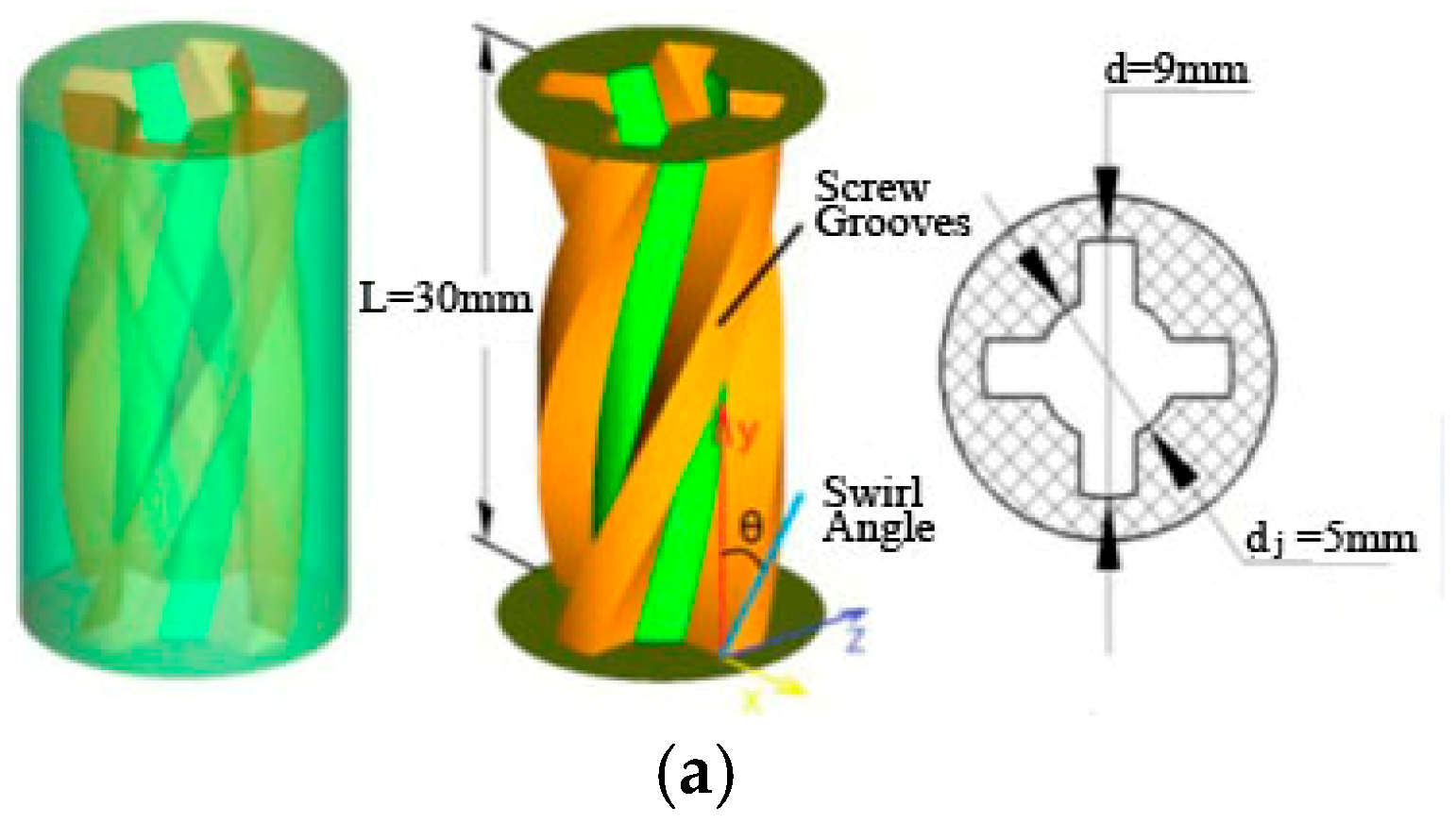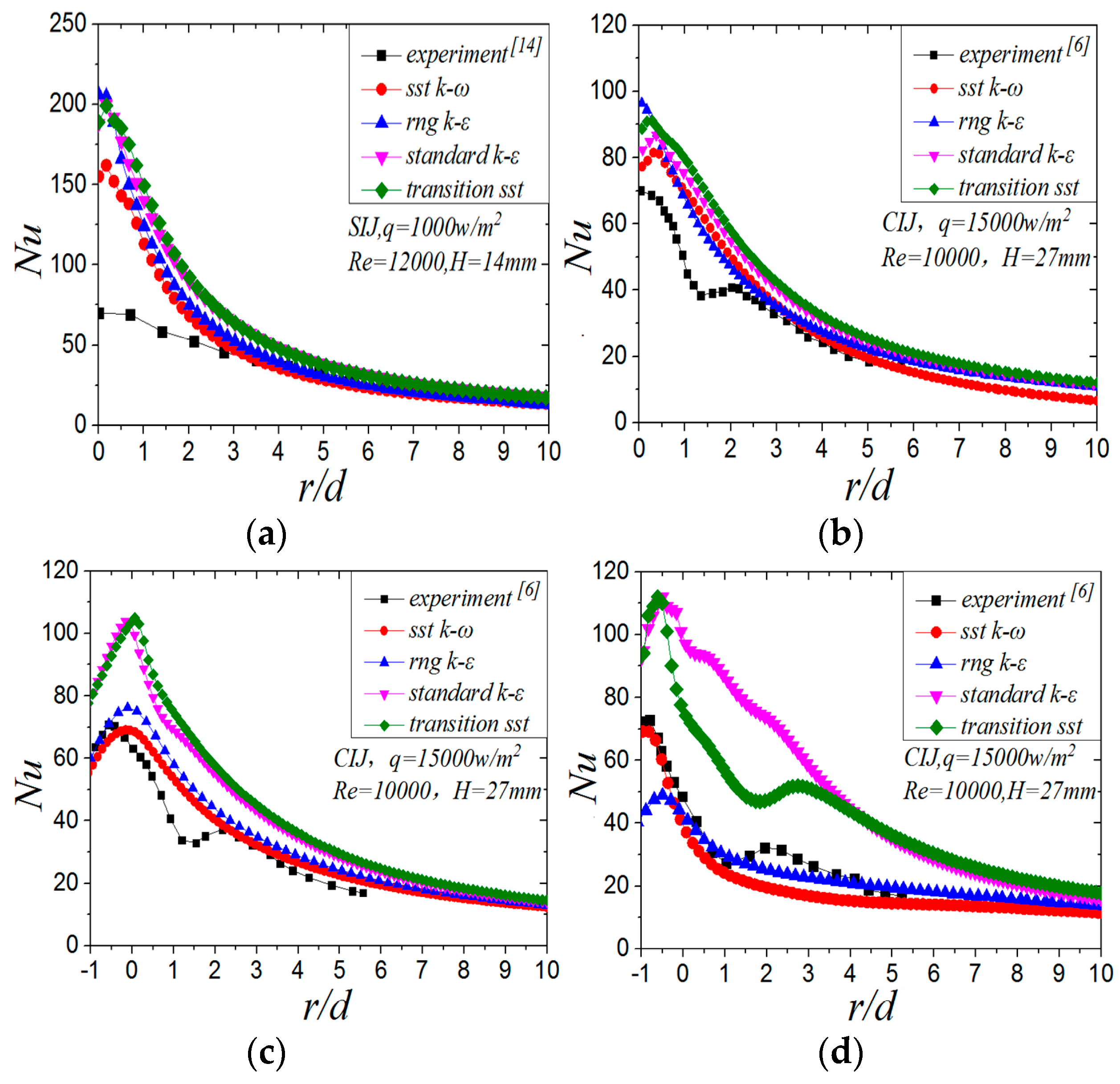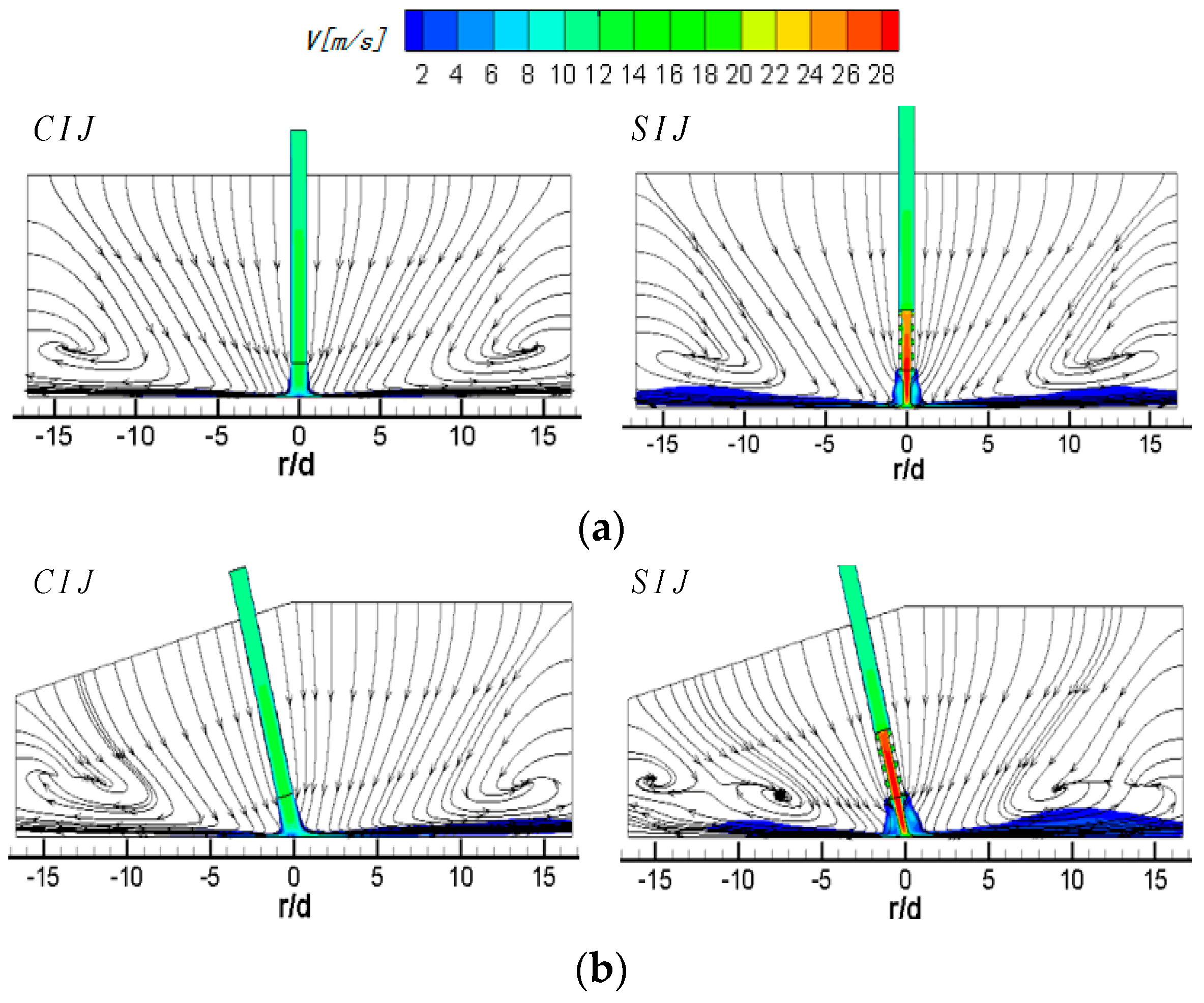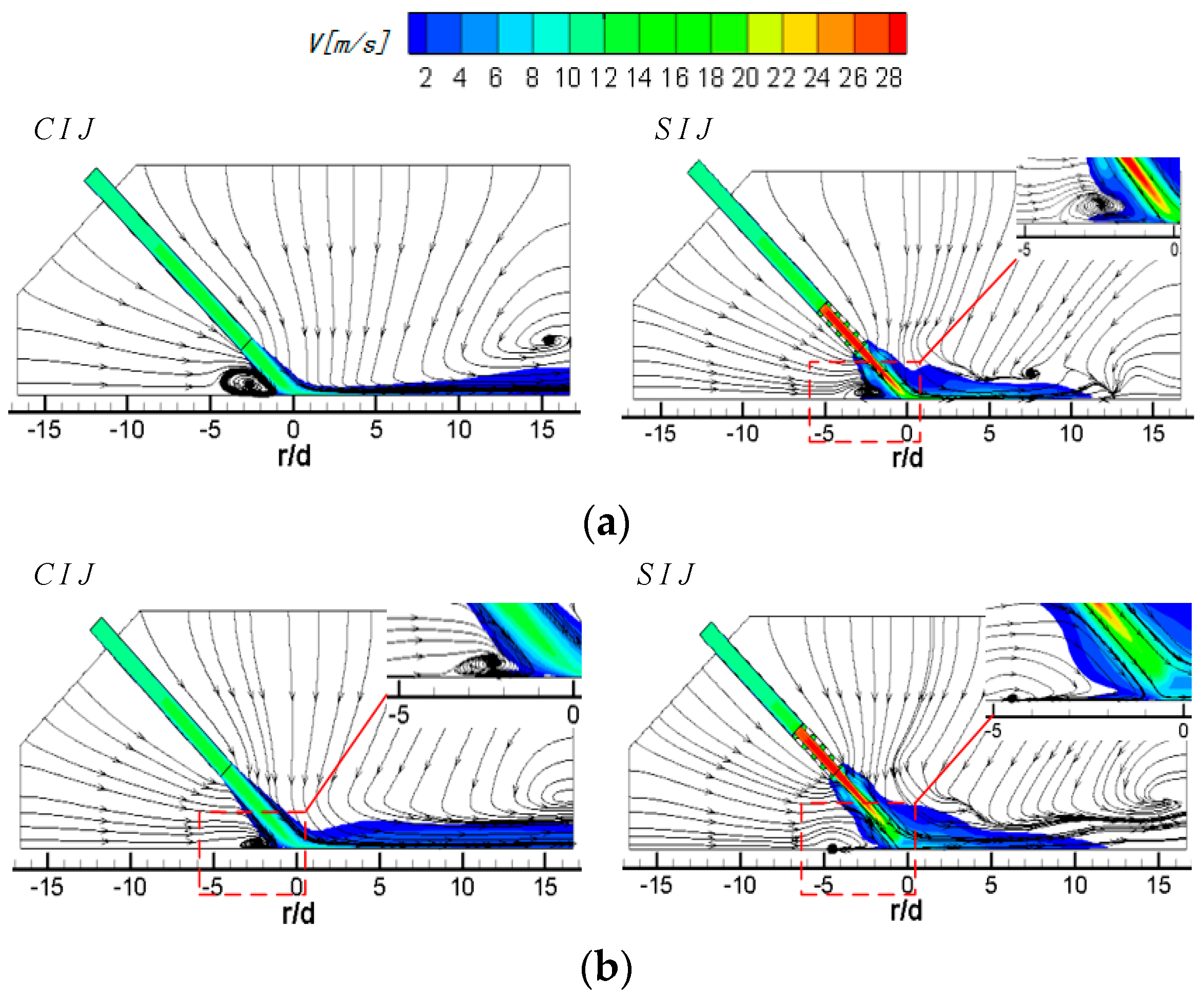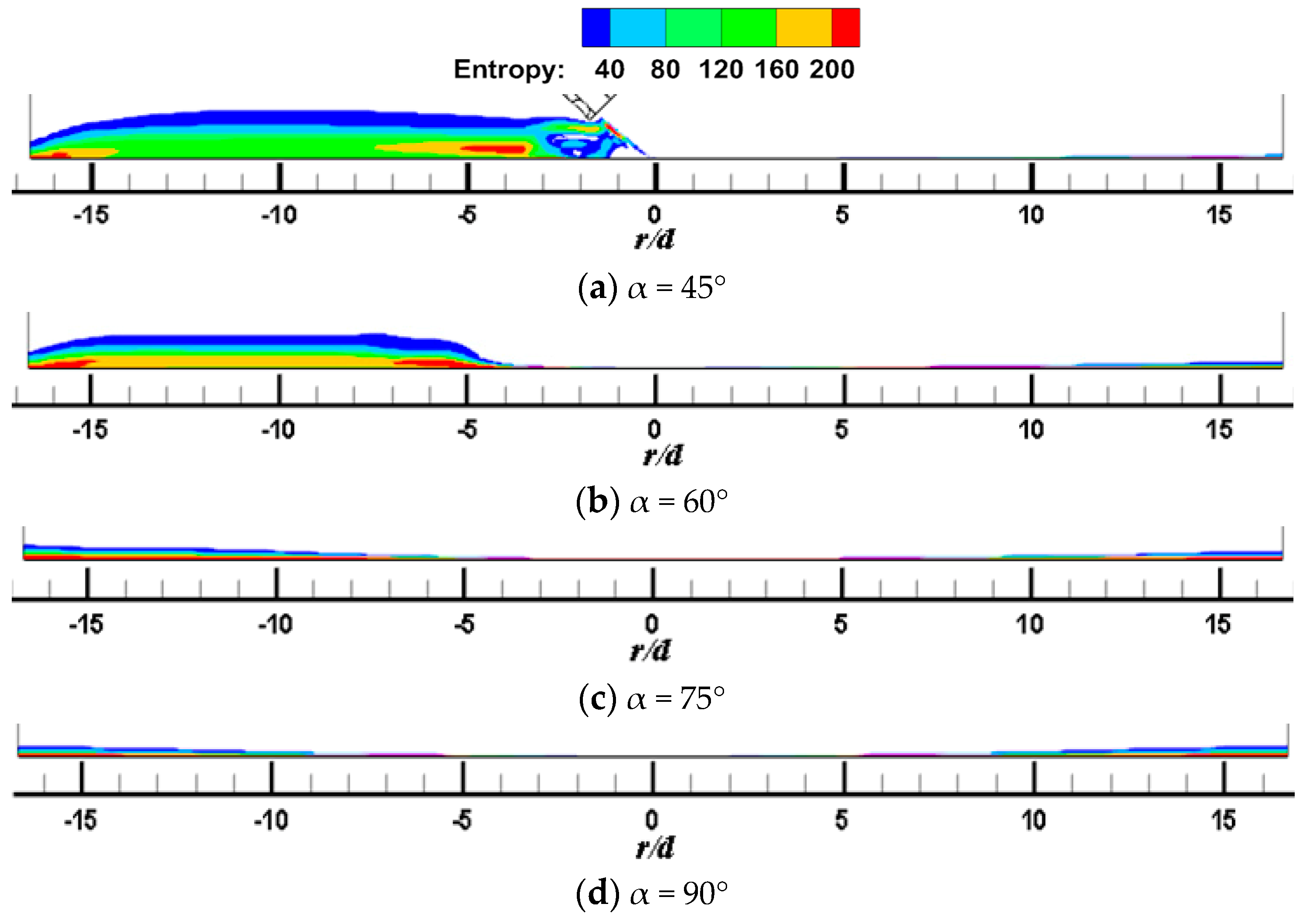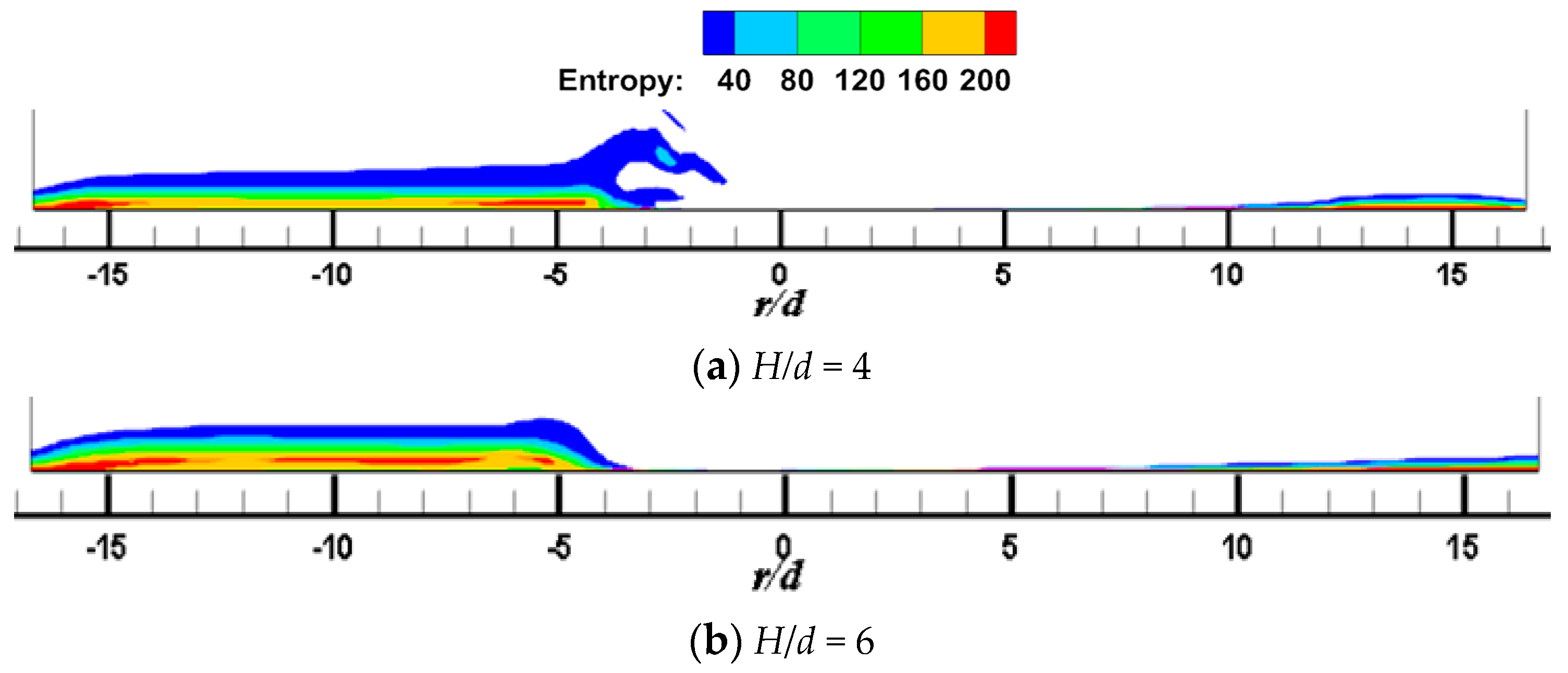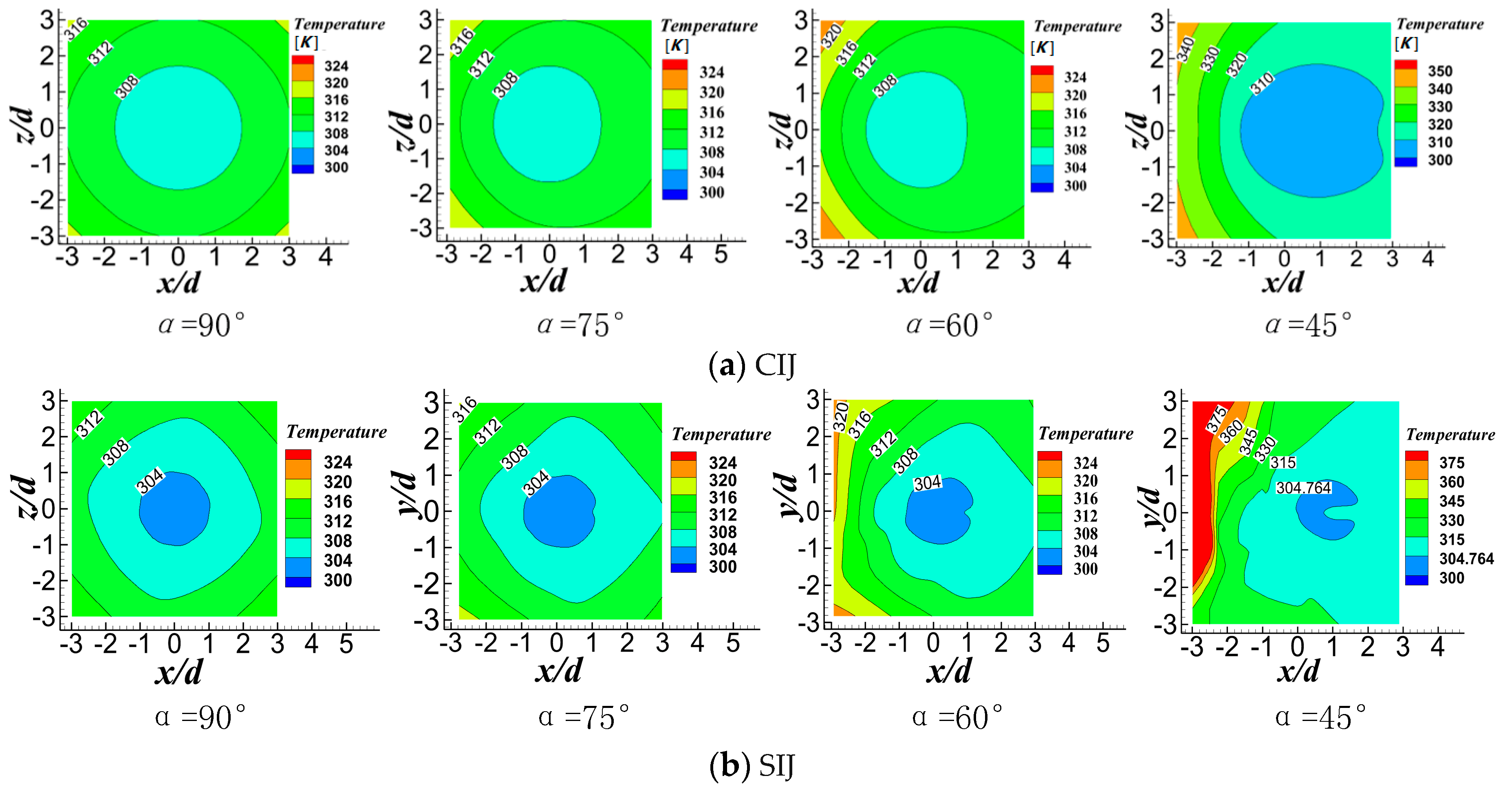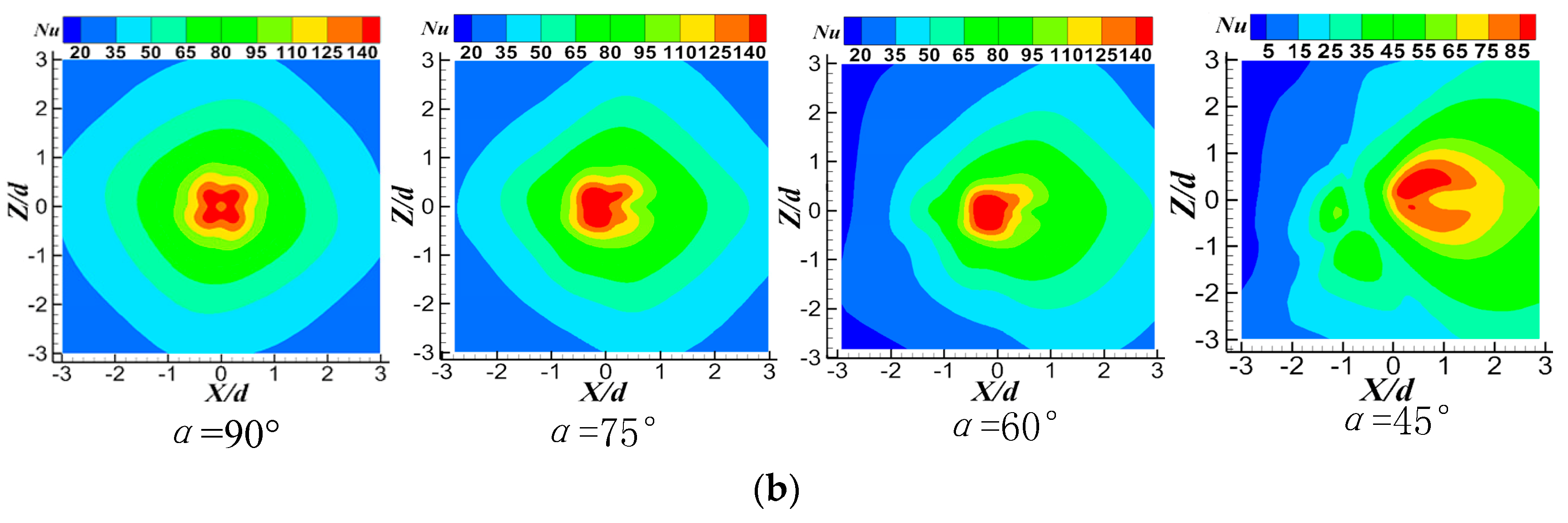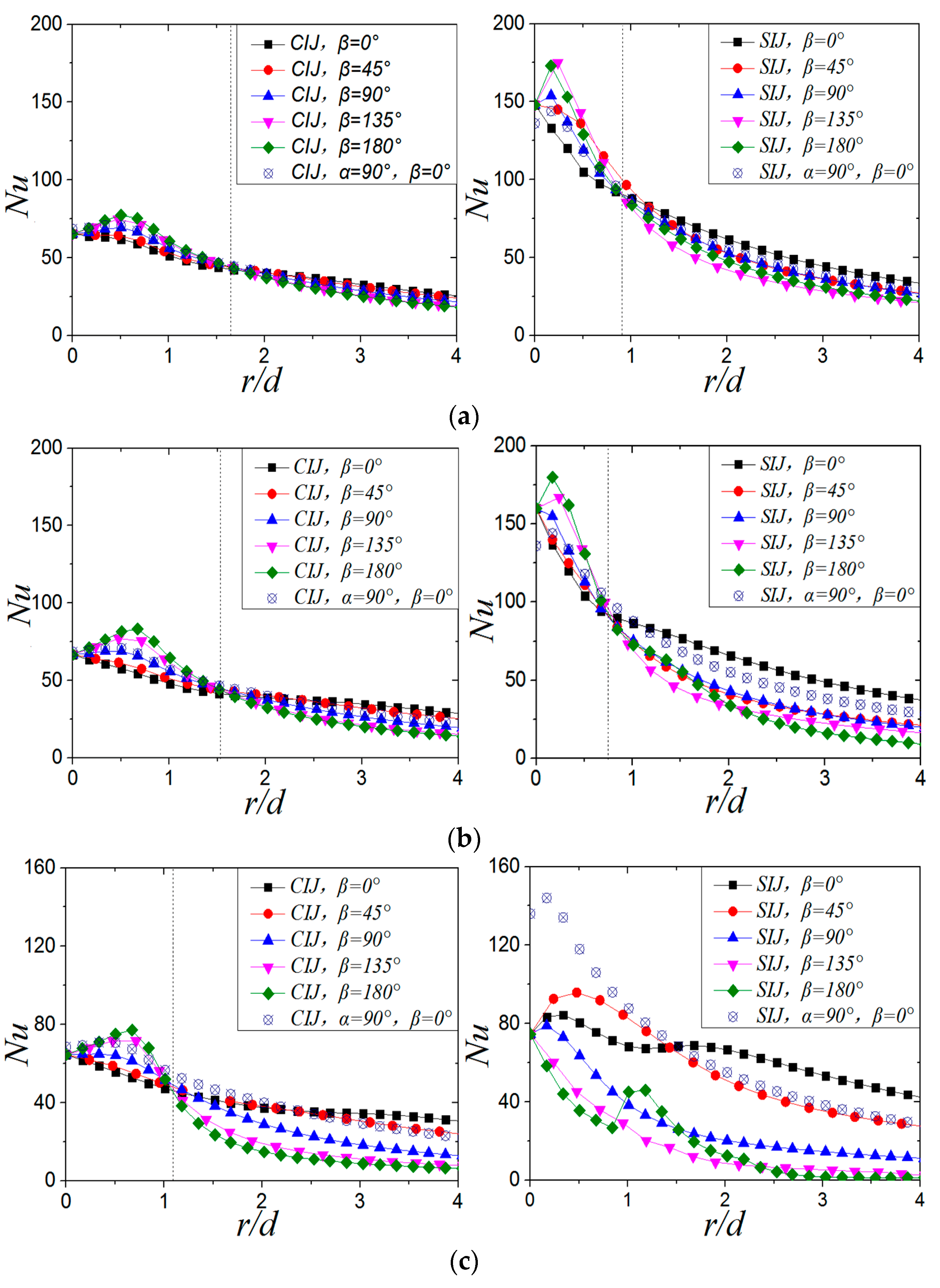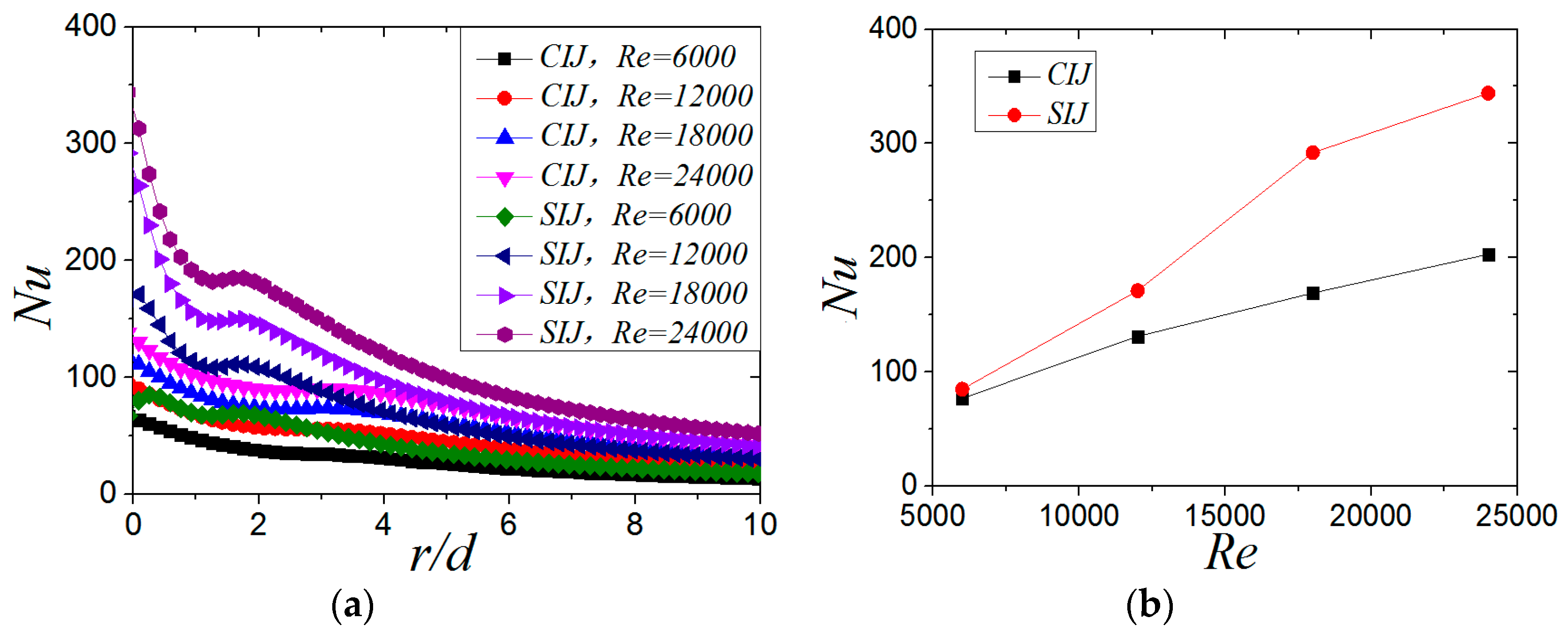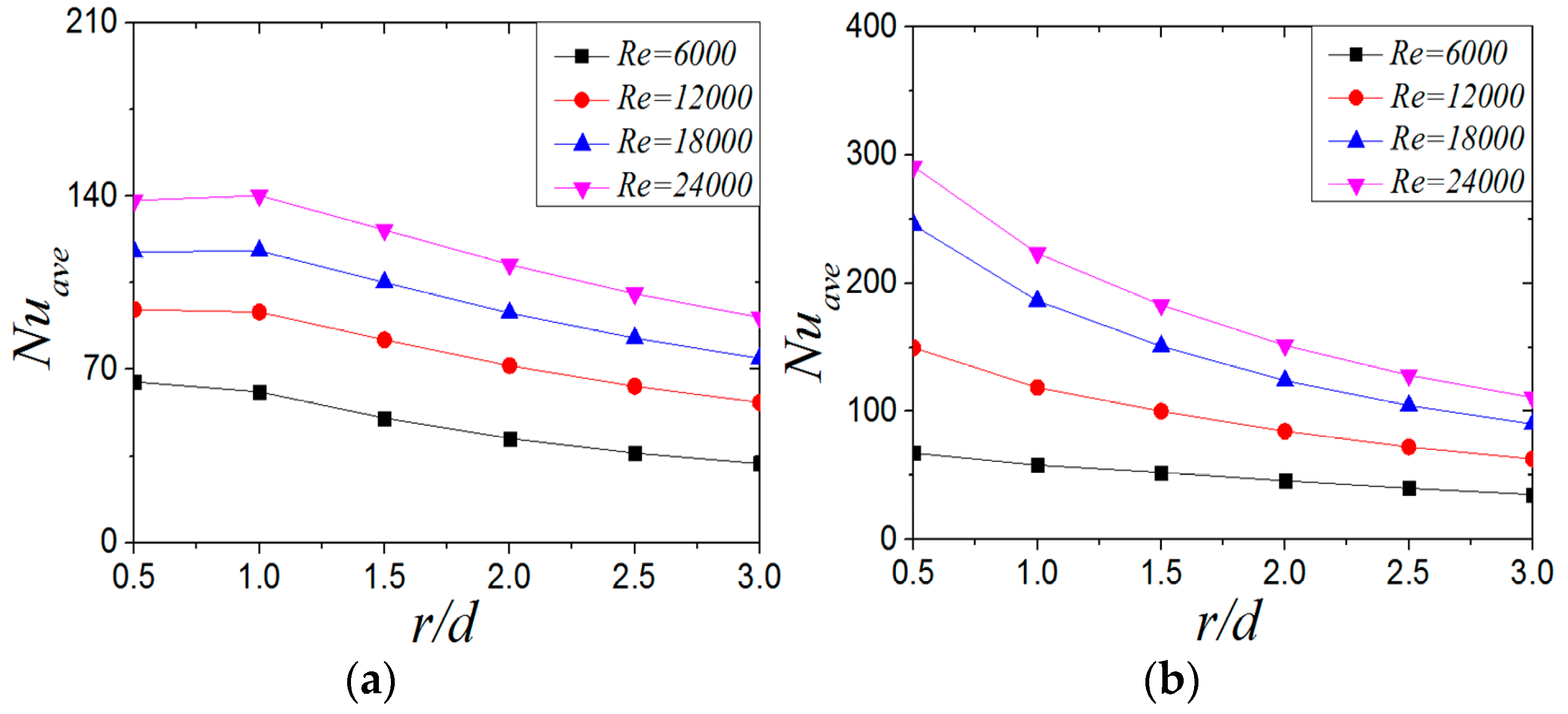3.1. Flow Field
Figure 4 shows the streamlines and velocity distribution of circular and swirling jet in the Z
0 plane at different inclination angles at
Re = 6000 and
H/d = 2. The left side of the nozzle is a traditional smooth circular hole and the right side is the 45° threaded hole. When the vertical jet (
α = 90°) is applied, the flow field and velocity field are symmetrical in both the circular and swirling jets. In
Figure 4a, it is obvious that the high-speed impinging jet from a smooth circular hole entrains the surrounding air. The entraining air and the air flowing out of the jet space after the wall jet form a large recirculation vortex, and the center of the vortex is located at
r/d = ±13.5. In the case of the vertical SIJ, because the swirling jet has a stronger entrainment effect on the external air flow, it can be seen that the position of the vortex center is closer to the stagnation point of the jet than that of the smooth circular hole jet, which appears at
r/d = ±12. At the same time, owing to the blocking effect of the internal threads, most of the airflow is ejected from the central region of the threaded holes. Compared with the smooth circular holes, the jet velocity at the central region of the exit for the swirling jet has a bigger value and the potential flow develops further in jet space, shown as the red region in
Figure 4a, which will enhance the transfer effect of the jet stagnation zone.
When α is equal to 75°, for the circular hole jet, more air flows downstream of the plate, and the entrainment effect of the jet on the upstream direction of the plate is enhanced, which causes the upstream direction wall jet to occur earlier than that of the vertical jet, so the center of the recirculation vortex is slightly close to the stagnation point, and the expansion area of the vortex is also increased. For an SIJ, the recirculation vortex upstream of the target also moves towards the stagnation point of the jet by a stronger entrainment of potential flow and the location of its center is about r/d = −7.5. Compared with the circular hole jet, a new entrainment vortex adjacent to the outlet boundary of jet space is formed at r/d = −15. This may be that there are mixeds region of two stream flows, one is the wall jet flow out of jet space with a tangential velocity component and the other is the surrounding airflow entrained by the circumfluence vortex. In the downstream region, the wall jet occurs closer to the stagnation point, the central of the recirculation vortex moves ahead to the location of about r/d = 9, and a half-baked entrainment vortex also appears at the exit of the jet space. Meanwhile, the wall boundary layer thickness of the airflow near the downstream region of the wall jet increases correspondingly, which will weaken the heat transfer performance of the wall region.
When α is equal to 60°, the center of the circumfluence vortex in the upstream direction of the CIJ moves to about r/d = −7. At this time, the range of the vortex is further expanded, but there is still a small amount of airflow escaping from the upstream direction near the target surface. In the downstream direction of the target, most of the airflow flows out from the downstream region and the suction effect on the surrounding airflow of the downstream outlet boundary is very weak. The flow with radial velocity as the dominant factor has a certain entrainment effect on the upper low-speed flow in the jet space. In the region of about r/d ≥ 8, the disturbance flow caused by the entrainment effect can be clearly seen, and a recirculation vortex with an obscure central occurs at about r/d = 10. For the SIJ, because of its strong entrainment effect on the external air flow in the upstream region, the rebounding airflow in the stagnation region is suppressed, and then a small area of wall-like corner vortex is formed at r/d = −4. At this time, there is no jet escaping from the upstream area. All the jets escape out of the jet space from the downstream, and the velocity of the airflow near the downstream target surface increases, which has a strong entrainment effect on the upper airflow in the jet space. It can be seen that an obvious entrainment vortex is formed at r/d = 7.5. With the gradual weakening of the outlet airflow, the entrainment effect is gradually weakened, and the height of vortex in the jet space is gradually reduced.
When α is equal to 45°, all the airflow of the CIJ escapes out of the jet space from downstream of the target surface. A low-speed large recirculation vortex occupies almost the whole jet space in the upstream region and is suppressed the upstream wall jet of the rebound jet in the stagnation zone, which will seriously deteriorate the heat transfer performance in the upstream region. In the downstream region, the airflow increases obviously, and the wall jet moves outward. The entrained airflow is not seen until the region of r/d ≥ 12.5. For the SIJ, the entrainment airflow mostly comes from the upstream region, which suppresses the rebound airflow in the stagnant zone to develop along the upstream region. A very small wall-like corner vortex is formed near the stagnation point about r/d = 2. At the same time, the location of the wall jet also moves out in the downstream region of the target surface, but, owing to the strong entrainment effect of the airflow near the wall, a distinct entrainment vortex is formed in the exit region, and the center of the vortex is about r/d = 15.
In conclusion, for the smooth circular impinging jet, reducing the inclination angle causes the recirculation vortices in the upstream direction to move toward the stagnation point, and the intensity of the recirculation vortex increases gradually; even the low-speed recirculation flow occupies the whole upstream jet space. For an SIJ, with the decrease in the inclination angle, the recirculation vortices of upstream jet space gradually weaken; the rebound airflow in the stagnant zone is suppressed by more and more the entrained airflow from the upstream region, and eventually becomes a wall-like corner vortex near stagnation point. When the circular hole jet is inclined to 45°, all the impinging jets escape out of jet space from the downstream region, while that situation happens at α = 60° for the SIJ without a large recirculation vortex in the upstream region. Even when all the airflow escapes out of jet space from the downstream region, there is a smooth suction airflow in the upstream region for the SIJ, thereby improving heat transfer performance in the upstream region. Secondly, by comparing the velocity contours of swirling jet and circular hole jet, it can be clearly found the flow velocity at the hole exit of the SIJ is obviously higher than that of the CIJ owing to the use of threaded holes, which makes a higher convective heat transfer capacity near the stagnation zone.
Figure 5 shows the streamlines and velocity contours of CIJ and SIJ on the Z
0 plane with different jet-to-plate distances at
Re = 6000 and
α = 45°. When
H/d is equal to 4, compared with
H/d = 2 (
Figure 4d), the surrounding airflow entrained by the potential flow mostly comes from the upstream region of the jet space, and the rebound airflow in the stagnation zone is restrained; thus, a wall-like corner vortex is formed at
r/d = −2.5. With the increase in the jet-to-plate distance (
H/d = 6), the corner vortex is further suppressed, and the extended region is greatly reduced. In the downstream, owing to the entrainment of airflow near the wall, an obvious entrainment vortex is formed in the exit region, and the center of the vortex is close to the exit region (r/d ≥ 15). For the inclined SIJ with a large jet-to-plate distance (
H/d = 4), the airflow sucked into the upstream direction can also flow smoothly from the outside surrounding airflow. The wall jet of the rebound air flow in the stagnation zone is also suppressed by these suction airflows and forms a wall angle-like vortex near the stagnation point. Compared with the CIJ under the same working conditions, the expansion range of the vortex is smaller and closer to the stagnation point. When
H/d is equal to 6, the recirculation vortex disappears, but when the suction airflow near the wall in upstream region meets with the rebound jet in the stagnation zone, a very small vortex is formed at
r/d = −4. In the downstream region, because the downstream airflow contains tangential velocity components, and there are double effects of shear and entrainment on the airflow near the wall, the downstream airflow is very disordered without the vortex.
Figure 6 shows the streamlines and velocity contours of CIJ and SIJ with different Reynolds numbers at
α = 45° and
H/d = 2. When the Reynolds number increases from 6000 to 24,000, the suction effect of the jet on the external airflow increases gradually with the increase of the velocity of the impinging jet. The more the airflow in the upstream region is entrained by the CIJ, the stronger the suppression effect on the recirculation vortex and the smaller the scale of the upstream vortex. However, the radial position of the center of the vortex is basically kept at
r/d = −8.5, but the height tends to the target, that is to say, with the increase of
Re number, the rebound airflow in the stagnant zone is more restrained on the upstream wall jet, so it is difficult for it to escape from the upstream. In the downstream region, with the increase of
Re number, the outflow of downstream air is increased. Although the radial position of entrainment vortex in the exit of jet space does not change significantly, the expansion scale increases slightly. For the SIJ, the low-speed recirculation vortex in the upstream region can be effectively eliminated. With the increase of
Re number, the scale of the wall-like corner vortex formed at
r/d = −2.5 in the stagnation zone decreases, so that the outer airflow entrained from the upstream region can participate in the downstream flow more smoothly. In the downstream region, the distribution of the flow field is basically the same as that of the circular hole jet. Under different
Re numbers, a distinct recirculation vortex is formed near the exit region of the downstream jet space. However, with the increase of
Re, the size of the vortex and the position of the center of the vortex do not change significantly.
3.2. Entropy Analysis
In this Section, entropy generation processes are analyzed to identify and quantify the causes of irreversibilities evolving in such inclined impinging cooling arrangements. As a second law of the thermodynamics analysis method, entropy production is be able to get the amount of irreversible loss and clarify the irreversible loss distribution in a flow and heat transfer system of concentrated irreversible phenomenon. Of course, entropy generation is an important optimization indicator to design a thermal system in terms of local entropy imbalance in the actual operation.
The volumetric entropy generation rate can be formulated as follows [
33,
34]:
The right side of the equation is the volumetric entropy generation due to the heat transfer.
Figure 7 and
Figure 8 shows the local entropy contour by heat transfer of the CIJ at different inclined angles on the Z
0 plane when
H/d = 2 and
Re = 6000. The entropy production resulting from different flow configurations computed due to heat transfer is determined. In
Figure 7, it appears that the entropy is predominantly produced in the regions in the vicinity of the impinged wall, that is, it may be the result of a large contribution of temperature transfer gradient and shear-induced turbulence mixing in these regions. The simulated results are consistent with those found in the literature. At the same time, the large entropy is the red areas corresponding to the regions near the jet axial outlet boundaries; this occurs because of the rapid temperature change across the jet axial outlet boundaries, that is, the temperature gradient is large in these region, which in turn results in a high entropy generation rate. For the same reason, the red area in the jet space corresponds to the flow vortex region, where the temperature gradient is relatively large. Under inclined conditions, entropy generation of CIJ and SIJ in the upstream is larger than that in the downstream and, with the increase in the inclined angle, the regions of large entropy generation extend. When α is equal to 75° and 90°, the region of large entropy generation is very small, while when α is smaller than 60°, the region of large entropy generation expands very rapidly. Compared with the CIJ, entropy generation of the SIJ in the upstream region is increased significantly as a result of more suction circumambient airflow, while that in the downstream region is weakened as a result of more homogeneous mixed with the airflow from the jet space. When α is equal to 45°, the whole region of entropy generation for the SIJ appears in the upstream region, the maximal entropy generation is the region of
r/d = 4 corresponding to the wall jet region, and the vortex of entropy generation is the location of the wall-like corner vortex. It should be noted that reducing the inclined angle and use of the swirling flow can lead to a larger entropy generation, and the latter is the key measure. Therefore, the cooling/heating configuration with the SIJ will have a larger entropy generation under the same conditions compared with the CIJ.
Figure 9 and
Figure 10 show the local entropy contour by heat transfer of CIJ and SIJ at different impinging distances on the Z
0 plane. In
Figure 9, for a round hole jet, when
H/d = 4, the region of entropy generation in the upstream direction is larger than that at
H/d = 2. This is because increasing the impinging distance makes more air entrainment and flow mixing in the upstream direction, thus making the temperature gradient change more violent. When the impact distance increases further, the region of entropy generation decreases. In
Figure 10, for the SIJ, the entropy generation region decreases with the increase of impinging distance.
Figure 11 and
Figure 12 show the local entropy contour by heat transfer of the CIJ and SIJ at different Re on the Z
0 plane. For the CIJ, increasing the jet Reynolds number has little effect on the region of entropy generation near the wall, while for the SIJ, the region of entropy generation in the upstream direction will gradually decrease, while there is almost no entropy generation in the downstream direction.
3.3. Local Heat Transfer Characteristics of Target Surface
Figure 13 shows the temperature contours of CIJ and SIJ at different inclination angles when
Re = 6000 and
H/d = 2. Whether it is CIJ or SIJ, reducing the inclination angle will reduce the uniformity of temperature distribution on the plate surface and there is a bigger area of high temperature in the stagnation zone.
Figure 14 shows
Nu number contours of CIJ and SIJ at different inclination angles when
Re = 6000 and
H/d = 2. For the vertical circular impinging jet, the stagnation zone is the maximum heat transfer region, and it is symmetrically distributed around the stagnation point near r = 0.5 d at a small jet-to-plate distance. At the same time, it can be seen that, with the decrease of the inclination angle of the jet, heat transfer performance on the downstream region of the target surface is enhanced, while the heat transfer performance in the upstream region of the target surface is seriously degraded, and the area of
Nu peak region is also gradually reduced, that is to say, heat transfer uniformity of the whole target surface is deteriorated. Owing to the existence of four spiral grooves in the nozzle, four local
Nu number peaks (140) are symmetrically distributed in the stagnation zone. When the jet is inclined, the two peak areas of
Nu number in the downstream region disappear, and the other two peak areas in the upstream region extend into a larger area. At the same time, heat transfer performance can be maintained in the 1.5 d rectangular region of the peak region, which may be because of the rebound flow in the stagnation zone when the swirling jet is used. The maximum
Nu in the upstream region of the stagnation zone also is degenerated to about 80 at 45°, and there are two secondary heat transfer peak areas on the upstream region of the stagnation zone, where there is also the region of the rebound airflow. Compared with the CIJ, the SIJ issuing from the new nozzle can greatly improve the heat transfer capacity in the stagnation zone of
r = ±0.5 d, while maintaining a higher heat transfer performance in the rectangular region
r = 1.5 d near the stagnation point. Even when the inclination angle is at a minimum, the peak value of
Nu can reach heat transfer performance of the vertical circular impinging jet.
Figure 15 shows the variation curve of local
Nu number on target surface of CIJ and SIJ at different inclination angles when
Re = 6000 and
H/d = 2. As can be seen from
Figure 15, when the jet is vertical impingement, in the direction of
β = 0°, the local
Nu number at the stagnation point and the maximum
Nu number for the SIJ increase by 98.5% and 114.6%, respectively, compared with the CIJ.
When α = 75°, it can be observed that, for CIJ and SIJ, the maximum Nu on the target surface is in the upstream region. In the range of 0 < r/d < 1.65 d, the Nu number in the upstream region for the CIJ is higher than that in the downstream region, while in the case of r/d > 1.65 d, the Nu number in the downstream region is higher than that in the upstream region; for the SIJ, the turning point of Nu number distribution in the upstream and downstream regions is at r/d = 0.9. At this time, local Nu number at the stagnation point and the maximum Nu number of the SIJ increased by 125.9% and 126.4%, respectively, compared with the circular jet. When the inclination angle is decreased from 90° to 75°, local Nu number distribution on the target surface does not change significantly for circular jet; while for the swirling jet, local Nu number at the stagnation point does not change significantly, but the maximum Nu number increases by 14.4%.
When α = 60°, the maximum Nu number of the target surface is still in the upstream region, whether it is a circular jet or a swirling jet. Compared with α = 75°, the turning point of Nu number distribution in the upstream and downstream regions for circular hole jet is slightly ahead, while it is at r/d = 0.75 for the swirling jet. At this time, the local Nu number at the stagnation point and the maximum Nu number for the SIJ increased by 139.9% and 116.3%, respectively, compared with the CIJ. It can also be seen that the radial position of local maximum Nu on the target surface of threaded and circular holes does not change significantly with the inclination of the jet from 90° to 60°. In terms of the local Nu value, the inclination does not weaken the heat transfer capacity near the stagnation zone on target surface of the CIJ and SIJ.
When α = 45°, the maximum Nu number of circular jet is still in the upstream region, and the turning point of Nu number distribution on the target surface is r/d = 1.1 d, while the Nu number in downstream direction of SIJ is always higher than that in the upstream direction. Compared with the CIJ, local Nu number at the center of the target surface and the maximum Nu number for the SIJ increased by 15.48% and 24.25%, respectively. Compared with the case of α = 60°, local Nu number at the stagnation point and the maximum Nu number of the circular hole jet at α = 45° have no obvious change, but they decrease by 46.8% and 53.3%, respectively, for the SIJ. It can be seen that, when the inclination angle is 45°, heat transfer effect on the CIJ is not obvious, but the heat transfer ability of the SIJ deteriorates significantly.
In the case of the inclined jet, the cooling effect of the SIJ is significantly stronger than that of the CIJ in the stagnant zone. Even when the inclination angle is 45°, the center of the heated surface and the maximum Nu number of the SIJ are still higher than those of the CIJ. The main reason for this phenomenon is that the central airflow of the swirling jet has a high exit velocity in jet space, which results in a strong convective heat transfer ability in the stagnation zone. When the inclination angle is 90°, 75°, and 60°, heat transfer enhancement effect of the SIJ is mainly concentrated in the region of r/d < 3 compared with the CIJ. When the airflow enters the region of wall jet flow, heat transfer effect of SIJ and CIJ is almost the same, and the Nu value is about 20. As far as the radial position of the maximum Nu is concerned, because the high-speed central area in the center of the threaded hole is relatively narrow, the local Nu peak value position is closer to the stagnation point than that of the circular hole. The maximum Nu number of circular hole jet is located at r/d = 0.5 when α = 90° and 75°, and at r/d = 0.7 when α = 60° and 45°. For a swirling impinging jet, the maximum Nu is at r/d = 0.25 when α = 90°, 75°, and 60°, and at r/d = 0.5 when α = 45°. By reducing the inclination angle of the jet, the positions of the maximum Nu number of the two jets are far away from the stagnation point of the target surface.
Figure 16 shows local Nusselt number distribution of CIJ and SIJ at different jet-to-plate distances at
Re = 6000 and
α = 45°. When
H/d = 4, the maximum
Nu number of SIJ and CIJ is in the downstream region. At this time, the maximum Nusselt number of the SIJ is 85.5% higher than that of the CIJ. When the jet-to-plate distance increases from
H/d = 2 to
H/d = 4, the local
Nu number at the stagnation point and maximum
Nu number decrease by 24% and 33.7%, respectively, while the
Nu number at the stagnation point for the SIJ increases by 20.24%, and the maximum
Nu number has no obvious change. When
H/d = 6, the
Nu in the downstream direction is still higher than in the upstream direction. At this time, the
Nu number at the stagnation point decreases by 8.14%, and the maximum
Nu number does not change significantly. In addition, when
H/d = 6, the local
Nu number at the stagnation point and the maximum
Nu of the SIJ decreased by 54.85% and 45.6% compared with
H/d = 4. It can be seen that the jet-to-plate distance increases from
H/d = 2 to
H/d = 4 when the inclination angle of the jet is 45°, the Nu number of the jet impingement core area (
r/d < 1) decreases, but it does not change significantly when
H/d = 6. For an SIJ, the
Nu number at the stagnation point will increase when the jet-to-plate distance is increased to
H/d = 4, but it will decrease sharply when
H/d = 6. However, the maximum
Nu of the SIJ is always higher than that of the CIJ in any jet-to-plate distance. Increasing the jet-to-plate distance causes the maximum
Nu number of the CIJ to shift downstream, while that of the SIJ is opposite.
Figure 17a shows the distribution of local
Nu number of SIJ and SIJ along the X-axis (
β = 0°) at different Reynolds numbers when
H/d = 2 and
α = 45°. It can be seen from
Figure 17a that increasing the Reynolds number, whether it is the circular impinging jet or swirling impinging jet, can significantly increase the local
Nu number of the plate, but at a lower Reynolds number (
Re = 6000), the local
Nu distribution is more uniform. When the Reynolds number increases from 6000 to 24,000, the
Nu number at the stagnation point increases by 27%, 90%, 138%, and 141%, respectively, compared with the CIJ.
Figure 17b shows the maximum
Nu of SIJ and SIJ at different Reynolds numbers when
H/d = 2 and
α = 45°. With the increase of Reynolds number, the difference between the maximum
Nu number on the plate of SIJ and CIJ is gradually enlarged and tends to a certain value. When
Re ≤ 18,000, increasing the Reynolds number makes the heat transfer effect of the SIJ very effective. When the Re is increased, most of mass flow is converged in the central region of the nozzle, and air flow along the helical grooves increases slightly with the hampered effect of the inclusion. So when the Re is larger than 18,000, the rate of enhanced heat transfer is gradually weakened.
3.4. Average Nusselt Number of the Target Surface (Nuave)
Figure 18 shows the average
Nu number of CIJ and SIJ at different inclination angles when
Re = 6000 and
H/d = 2. For the CIJ, the
Nuave at the inclined angle of 45° is 4.9%~23.56% lower than that at the other larger inclined angles, and the
Nuave distribution on the target surface is very close at the inclined angles of 60°, 75°, and 90°, which shows that, for CIJ, changing the inclined angle (α ≥ 60°) of the jet has little effect on the overall heat transfer of the target surface. In
Figure 18b, when the inclination angle is 60°, 75°, and 90°, the
Nuave of the swirling impinging jet also changes slightly, but when the inclination angle is 45°, the
Nuave of the plate is much lower than that of the other jet inclination angles, and the decreased range is between 33% and 52.8%. Compared with the CIJ, the
Nuave of the SIJ is 38.5–95.6% higher when α = 90°, 38.7–109% higher when
α = 75°, 34–106% higher when
α = 60°, and 3.9–10.6% higher even when
α = 45°. In conclusion, the
Nuave number distribution of the CIJ is more uniform than that of the SIJ, but the
Nuave of the SIJ is significantly higher than that of the CIJ. When the inclination angle is reduced to 45°, the heat transfer performance for CIJ and SIJ will be deteriorated significantly.
Figure 19 shows the
Nuave of CIJ and SIJ with different jet-to-plate distances at
Re = 6000 and
α = 45°. For the CIJ, the
Nuave at a jet-to-plate distance of
H/d = 2 is 32.3%~52.4% higher than that at
H/d = 4, but it does not change much when the jet-to-plate distance increases from
H/d = 4 to
H/d = 6. It can be seen that, when
Re = 6000 and
α = 45°, the heat transfer effect on the plate is better than when
H/d = 2. For the
Nuave of the swirling impinging jet (
Figure 19b), the
Nuave at
H/d = 2 and 4 is higher than that at
H/d = 6. By comparing and analyzing the
Nuave of swirling impinging jet with
H/d = 2 and
H/d = 4, it can be found that the
Nuave of
H/d = 4 is higher than that at
H/d = 2 at the region of
r/d ≤ 1.3, but the opposite is true when r
/d > 1.3. When the jet-to-plate distance is the same, the
Nuave of the swirling impinging jet is higher than that of the circular impinging jet. On the basis of the analysis of the distribution of the
Nuave and the local
Nu numbers (
Figure 16) of the SIJ at
Re = 6000 and
α = 45° under different jet-to-plate distances, it can be considered that the swirling jet has a better heat transfer effect on the target surface when
H/d ≤ 4.
Figure 20 shows the distribution of the
Nuave of CIJ and SIJ at different Reynolds numbers when
H/d = 2 and
α = 45°. With the increase of Reynolds number, the
Nuave increases, and the increase of
Nuave of the SIJ is higher than that of the CIJ. For the CIJ, the
Nuave radial attenuation velocity does not change much at different Reynolds numbers, while for the SIJ, it increases gradually with the increase of Reynolds number. At the same Reynolds number, the
Nuave of the SIJ is higher than that of the CIJ, but considering the uniformity of heat transfer on the target surface, the Nusselt number distribution of the CIJ is more uniform.
